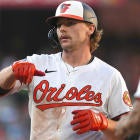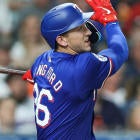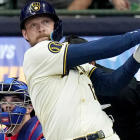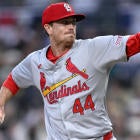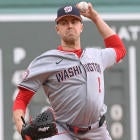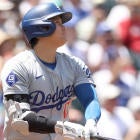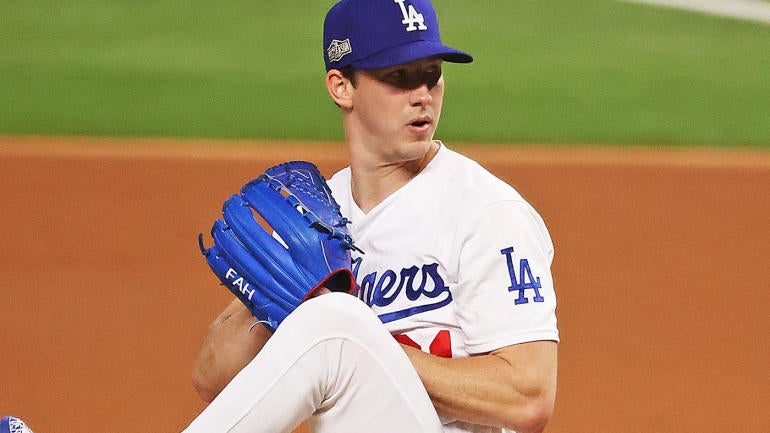
Starting pitchers cost more in 2021 Fantasy baseball drafts than ever before, but the results don't necessarily back up that approach to drafting. While the top handful of pitchers -- say, the top eight or nine, in any given year -- tend to return good value more often than not, after that, it's kind of a crapshoot.
I broke down the recent history of starting pitcher results in a piece here, and there was one especially interesting thing I found in the data: While starting pitchers are being drafted higher than ever in 2021, the last few seasons have actually seen an even worse return on investment on early-round starting pitchers. It would be one thing if we were getting better at drafting pitchers, but the evidence doesn't even back that up.
So, what do we do with this information when it comes to 2021 drafts? You could just skip early-round starting pitchers altogether, but that's a scary approach to take on Draft Day. It's a plan based on the knowledge that the hit rate for pitchers outside of the first round is 50% at best. So, while your pitching staff will look lackluster relative to your peers if you skip the position in the top-100 picks or so, you have to remind yourself that everyone's very impressive Opening Day staffs will suffer from the attrition rate before long.
The system
But, what if you can identify the pitchers likely to hit and bust ahead of time and draft accordingly? As part of my research for that previous article, I put together a rudimentary system for trying to figure out the chances of hitting on a pitcher in any given season. I took a look at the pitchers' previous season before they were drafted and their previous three seasons, and awarded one point for each 200-inning season and one point for each season finished as a top-100 overall player, plus an added point if the pitcher was a top-50 finisher the year before they were drafted; I also deducted one point if the pitcher was over the age of 30, 33 or 35. Like I said, it's simple, but it backs up what we should be looking for in starting pitchers: A proven track record of success and durability.
Despite being simple, the results back up what we're looking for. Pitchers can have as many as nine or as few as negative-two points by this scale, and here's how the hit rate breaks down by each scoring range (a "hit" is defined as a top-100 overall finish) for all starters drafted inside the top-100 picks from 2020 through 2017:
- 8-9 points: 7/8 (87.5%)
- 6-7 points: 6/13 (46.2%)
- 4-5 points: 7/19 (36.9%)
- 2-3 points: 8/30 (26.7%)
- (-2)-1: 10/27 (37.0%)
All in all, this fits in with the data I showed in this piece on starting pitcher hit rates by ADP: The top tier hit at a high rate, the next tier at around 50%, and after that, around two-thirds of starters bust. It's interesting to note that the hit rate spiked at the bottom tier, and you might be inclined to draw some conclusion from it, but I'm not sure there's much there. The hits are split evenly between players who are 29 and older and those who are 27 and over.
However, one interesting note does shine through: Only one of those hits came from a player drafted inside of the top 55 in ADP. The hit rate on players drafted inside the top 50 on the low end of the spectrum was just one out of eight, compared to six out of 15 for players in the 2-3 score range.
All of this should be fairly intuitive: The players with the best chance of being a good Fantasy option are those who have proven they can do it, and the worst investments, thus, are those who come with a high price tag without having proven they can do it.
So, that gives us a template for identifying the best targets and riskiest bets for 2021.
Best targets
In terms of who to target, your best bets are, unsurprisingly, clustered in the early picks: Gerrit Cole, Jacob deGrom, Shane Bieber, Aaron Nola, and, surprisingly, Trevor Bauer. This fits in with the overall picture at SP referenced in the previous paragraph and might be the strongest case possible for doubling up on aces in the first two rounds, provided you ignore the position for the next eight or so rounds to bulk up on hitting. That way, you're maximizing your overall hit rate while lessening the negative impact of your inevitable starting pitcher misses.
There is one wrinkle to using this approach for this season: Nobody threw 200 innings in 2020, so the maximum point total someone can get is seven. You can adjust to a 200-inning pace for 2021, but I think this sort of highlights one of the other inherent issues with the push to draft starting pitchers earlier than ever in 2021: We're making these decisions with incomplete information. We don't know who might have broken down over a full 2020 season, or who would have seen their numbers dramatically change from games 61 through 162.
So, for the purposes of this, I won't be adjusting the inning criteria. I think that better highlights the risks we're facing with this year's draft pool, and why the inflated costs for starters in 2021 drafts make even less sense than the historical data suggests. However, one thing I will say is, if a pitcher has shown the ability to get to, say, 180 innings in the past and they are a veteran who likely won't be handled carefully, I'm more willing to overcome innings totals as a shortcoming for this season, when 180 innings might end up putting you in the top 10 in baseball.
High bust scores
With all that being said, here are the 13 starters who enter 2021 with a bust score of one or below and are being drafted in the top 100 in NFC drafts. Remember, based on history we should expect about eight or nine of these guys to fail to provide a top-100 finish, with four to five finishing outside of the top 200 overall:
- Kenta Maeda (1) - 47.65: It's a bit hard to know what to make of Maeda, who was never given the opportunity to be a full-time starter for the Dodgers, primarily due to clauses in his contract that tied incentives to inning and games started totals. He's 33 and last year was a major outlier for his career, and while I don't especially mind his cost as SP16, it's best to make sure you don't reach for him.
- Yu Darvish (1) - 17.68: It would probably shock you to learn that Darvish hadn't been a top-100 player in Fantasy since 2013 before last season, however, he would have been there in 2019 with a bit better luck: He won just six games in 31 starts for an 84-win Cubs team. It's hard to classify Darvish as safe when he costs a second-round pick, but I would argue this is one player whom this method may underrate.
- Hyun-Jin Ryu (1) - 74.83: Ryu is another surprise here, but we know he's got a relatively low ceiling for innings and typically doesn't get the strikeout rates you're looking for from a high-end pitcher. That being said, he has a 2.30 ERA over the last three seasons with a FIP between 3.00 and 3.10 in each, and he's avoided any injuries over the last two. Like Darvish, Ryu's risk is probably overstated by this method -- it's capturing his relative lack of upside as much as anything, but as SP25 off the board, he's a fine option.
- Stephen Strasburg (1) - 72.75: Now we're getting somewhere. Strasburg has been a top-100 pick in every year of our sample, and he's finished outside of the top 200 twice. Of course, both times came when his ADP spiked to the second/third-round range, while his two good seasons came when he was outside of the top 50 picks. Based on that, this should be the time to buy Strasburg, as he is SP24 off the board. However, he's coming back from Carpal Tunnel surgery, and we just don't have a long history of pitchers coming back from that. If you're looking for ace upside, Strasburg has it, but there's a pretty good chance he doesn't bounce back this time.
- Walker Buehler (1) - 19.91: Arguably one of the most obvious fades on the board based on this method, he's probably the biggest eye-opener as a result of this exercise. Buehler has finished as a top-100 player once, when he was No. 73 in 2019. Even if you add in postseason, he didn't reach 200 innings in 2019, however. He threw more than five innings just four times in 13 starts including the playoffs in 2020. He's a great pitcher and could spend the next five years as the second coming of Zack Greinke, but with the way the Dodgers use him, the upside is capped. Even in a season where low inning totals should be less of a detriment to value than ever before, Buehler is an obvious avoid for me as SP7 in ADP.
- Luis Castillo (1) - 27.81: It is pretty surprising that Castillo has just one top-100 finish back in 2019. However, he did finish 101 in 2020 and would have clearly made it if the Reds had managed to win more than four of his 12 starts. Castillo threw 190.2 innings in 2019, as well, so he would look better if the threshold was 190 innings. Which is all to say, Castillo may not have the upside of a true ace pitcher, but he's a better bet than this exercise probably grants him.
- Jack Flaherty (1) - 30.56: Flaherty is a really tough pitcher to make sense of. He's pitched at a true ace level for basically half of one season -- his 0.93 ERA in the final 16 starts of 2019 -- and he followed that up with a pretty lousy showing in 2020. However, he nearly hit 200 innings in the regular season in 2019 and had 213.1 if you include the postseason, and there were some extenuating circumstances to his 2020, even more so than for most players. The Cardinals had the worst COVID-19 outbreak of any team early in the season, and Flaherty went nearly four weeks between starts. That means he had to ramp up his activity in January and February to prepare for the expected start of the season, then shut down until June, before ramping up again for the delayed season start, only to shut down again after making one start. As excuses go, "I had to set up a makeshift mound in my hotel room to get work in during a quarantine," is a pretty good one, though Flaherty is still getting an awful lot of credit for that second half of 2019 to be the No. 11 pitcher coming off the board.
- Blake Snell (1) - 47.43: The risks with Snell are obvious: He's never been a particularly efficient pitcher, failing to average six innings per start even in his breakout 2018 season. He was right around the middle of the pack in terms of pitches per inning that season, but would have had the fourth-highest mark in 2019 and would have been fifth in 2020 if he had enough innings to qualify. His limited innings totals aren't totally the fault of the Rays' handling of their pitchers, in other words. Plus, he had elbow surgery in the summer of 2019 and then had a cortisone shot in his ramp-up for the 2020 season due to soreness in the elbow. Snell is an elite strikeout pitcher who should benefit from the move to the National League, but for a risk/reward pick, the low innings ceiling may limit the upside, too. Is he really worth the risk in the fourth round?
- Jose Berrios (1) - 86.09: At this point, I don't think anyone really expects an elite season from Berrios, and at his cost, that makes him a relatively low-risk option. He uncharacteristically struggled with his command in 2020, which helps explain why he failed to average six innings per start for the first time since 2017. Berrios seems pretty unlikely to finish as a top-15 starting pitcher, but his steady hand seems equally unlikely to ever lead to results that really hurt you. At this point in the draft, he's an unexciting but worthwhile option, especially if you can't help but invest in riskier pitchers early on.
- Max Scherzer (0) - 29.02: In terms of recent performance, Scherzer is hard to argue against -- even a disappointing 2020 season saw him finish as the No. 34 SP. He gets dinged hard for his age -- he's the only pitcher inside the top 100 in ADP over the age of 34 -- and for his recent injuries. He was mostly OK in 2020, but he dealt with back injuries in 2019 that persisted for much of the second half and followed him into the postseason -- famously forcing him to be scratched from a World Series start. There's been less skills erosion so far than you might think, and I'm personally willing to buy in even ahead of his cost. But it's hard to argue he isn't extremely risky.
- Sonny Gray (0) - 65.46: Gray is probably less of a risk than his score suggests because he's clearly taken a step forward over the last two seasons, with a 3.07 ERA, 1.12 WHIP, and 10.8 K/9. The one place he clearly falls short is with innings, as he hasn't come close to 200 innings since 2015 and is averaging 5.5 innings per start over the last two seasons. 180 innings probably represents something like his absolute ceiling. However, because Gray is a veteran, the Reds may actually be willing to let him get there in 2021, which not a lot of pitchers can say, even in this range. I like him well enough at his ADP since his biggest shortcoming is less of a liability this season.
- Ian Anderson (0) - 97.45: Anderson doesn't shine by this measure, of course, because he was called up for just six starts in a shortened season, so he doesn't come close to qualifying for any of the criteria being measured. That being said, if there's one unproven guy I'm willing to reach for in 2021, Anderson is it. He's a top-24 starter for me. Call me a hypocrite, but the addition of an incredibly impressive changeup last season gives him top-10 potential, and while he'll likely have a relatively low innings ceiling, he could be borderline elite over his 120 or so innings, and that's a fine gamble at this point in the draft.
- Carlos Carrasco (-1) - 67.42: The biggest red mark on Carrasco's ledger is 2019, when he threw just 80 innings with a 5.29 ERA. Of course, he was diagnosed with leukemia midway through that season and returned following treatment to work out of the bullpen, so it's hardly fair to hold that against him. If you replace his 2019 with 2017, you add a 200-inning season with a top-50 overall finish. Carrasco is old, at 34, but he's one pitcher I'm willing to buy in on at his current price because I just don't hold the negatives in his track record against him.
- Zack Wheeler (-1) - 93.12: Wheeler basically the "Spider-Man-pointing-at-Spider-Man" meme with Berrios. He's unlikely to give you ace-level production, but it's hard to see the bottom falling out, either. He's averaging 6.3 innings per start over the last three seasons and threw 195.1 innings in 2019, so the workload should be there. If you get to this range of the draft and your rotation needs a steadying presence, go ahead and snag Wheeler.
So which 2021 Fantasy baseball sleepers should you snatch in your draft? And which undervalued first baseman can help you win a championship? Visit SportsLine now to get Fantasy baseball rankings for every single position, all from the model that called Will Smith's huge breakout last season, and find out.









